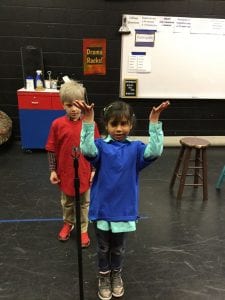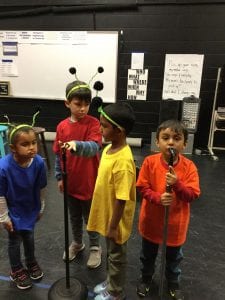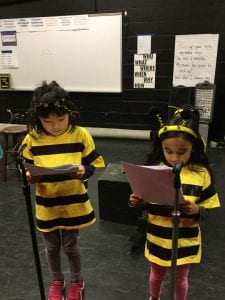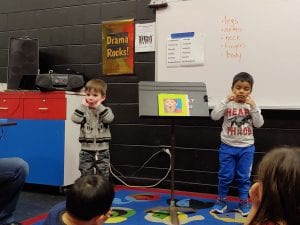REHEARSE and REVEAL
This blog focuses on 1st grade, Kindergarten, and Preschool
re·hears·al (/rəˈhərsəl/) – a practice or trial performance of a play or other work for later public performance.
In the theatre, a rehearsal is used to assist performers in learning dialogue and to set blocking and stage movement. There are rules to the rehearsal process:
- Attendance. A rehearsal must have the active participation of all those in the scene/play. The absence of one person can waste the time of the other actors. If an emergency requires an absence, it’s the responsibility of the actor or crew member to notify the director ASAP. No one should leave a rehearsal until dismissed.
- Promptness. It is expected that everyone involved in the rehearsal or performance will be on time and ready to begin at the scheduled time. This is so important that all cast and crew members should hold this as a high value and reminder to others.
- Use of Time. Although there is a social aspect to participating in theatre, time should be used for preparing for the play, line study or other useful activities.
- Meeting Deadlines. When the cast is scheduled to be off-book (memorized), it is expected that each cast member will know his/her lines.
- Quiet. There is rarely any excuse for talking (or other noise) in the rehearsal space by those not involved in the scene. Any unnecessary noise negatively affects concentration and focus – distracting from the rehearsal process.
- Guests. Individuals not involved in the rehearsal should not attend unless it is arranged through the director. Students interested in observing a rehearsal as a learning experience, should receive permission from the director.
- Rehearsal Props and Performance Props. Rehearsal props and performance props are there for one reason only–to be used in rehearsal or performance by the actor to whom they are assigned. Props are often borrowed and/or irreplaceable and should not be used by anyone other than the designated actor.
- Prompting. When actors require assistance with a line in rehearsal, they should remain in character and say “line.” They should not show their frustration, since this could interfere with the performances of the other actors.
- Direction. It is not uncommon for fellow cast members or friends to offer advice about how an actor should play a role. Remember, only the director is responsible for the scene/play. Actor etiquette says: An actor should never direct another actor.
- Technical Rehearsal. This is often the longest rehearsal of the entire process, and it is often the most important. It is the first time that most of the technical elements are joined with production. Patience is required for all involved. Actors may be asked to wear rehearsal clothing similar to their costumes. Remember that the technical crew has only a few hours to perfect their part of the production while the cast has been working for weeks.
- Dress Rehearsals and Performances. These final rehearsals require the total concentration of the performers and crew, but new elements still may need to be integrated into the production.
 For young performers, rehearsal seems a long, tedious and sometimes confusing process. When I call “Places, let’s take it from the top, again.” I often hear some moans and groans. We need to RE-view and RE-peat – which is the purpose of a RE-HEAR-SAL. Each time we run a scene or the show, we “re-hear” what we are doing and make any adjustment to make the story clearer and better. This process takes time but it gives the student actors a kinesthetic connection to delivering their lines. It may seem easy to understand, but this is challenging to produce at a young age.
For young performers, rehearsal seems a long, tedious and sometimes confusing process. When I call “Places, let’s take it from the top, again.” I often hear some moans and groans. We need to RE-view and RE-peat – which is the purpose of a RE-HEAR-SAL. Each time we run a scene or the show, we “re-hear” what we are doing and make any adjustment to make the story clearer and better. This process takes time but it gives the student actors a kinesthetic connection to delivering their lines. It may seem easy to understand, but this is challenging to produce at a young age.
The Kindergarten SEA TURTLES and STARFISH and the 1st grade DOLPHINS and BELUGAS, (along with the 2nd grade Tigers) have been working hard rehearsing for their play. All students should be memorized at this point, but some students are still uncertain of their cues. In order for any good character work and vocal expression to be achieved, the actor must be freed up from the struggle of grasping for lines. One is not “acting” only saying lines – this is not fun. My hope is for each student to experience, not only a sense of accomplishment, but the thrill of bringing a character to life! The students should be reviewing and working on their lines at home for at least 10-15 minutes each evening before performance.
Rehearsal Process:
Our Preschool – Otters and Lemurs have been talking about “feelings and emotions.” Feelings are important and are a normal part of us. We all have them. In drama class, we show emotions or feelings when we tell and act out stories. With our younger students, we have been identifying different feelings and expressing them with our faces and bodies.
One lesson had the students looking at pictures that showed different emotions. Then, they recreate what they see and their classmates try to guess what emotion they are expressing. We think about what a person may be thinking or saying when we see that expression. We also explored how situations or circumstances cause people to have varying reactions.
A warm-up exercise called Use or Become: The students are given an imaginary object to “use or become.”
THE NIGHT OF KNIGHTS IS THIS SATURDAY
See you there!






